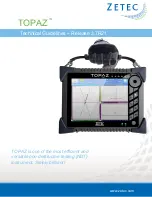
User’s Manual MSO/UPO2000 Seri es
37 / 137
Instruments.uni-trend.com
7.1
Noun Explanation of Trigger System
(1) Trigger Source
A signal for generating a trigger. Trigger can be obtained from a variety of information sources, such as
input channel (CH1, CH2, CH3, CH4), digital signal (D0~D15), external trigger (EXT, EXT/5), mains electricity,
etc.
a.
Input channel: Select any one of the analog signal input port CH1~CH4 on the front panel of the
oscilloscope as a trigger signal.
b.
Digital channel: when digital signal is connected and LA is opened, select any one of digital channel
as a trigger signal.
c.
External trigger: Select the input signal EXT Trig (Input port of EXT or EXT/5) on the front of the
oscilloscope as a trigger signal. For example, the external clock input to EXT Trig port to be a trigger
source, which includes EXT and EXT/5. EXT signal trigger level can be set within the range from–1.8
V~ +1.8 V.
d.
Mains electricity
:
Used to observe the related signal of mains electricity, such as the relation of
lighting equipment and power supply equipment, to obtain stable synchronization.
(2) Trigger Mode
Trigger mode determines the behavior of the wave during a trigger event. This oscilloscope provides
three kinds of trigger modes: auto, normal, and single.
a.
Auto trigger
:
When there is no trigger signal, the system automatically collect and display data.
When the trigger signal is generated, it automatically switch to trigger scanning, so that the signal
will be synchronized.
Auto trigger mode is suitable for
Check DC signal or signal with unknown electrical feature
Note
: This mode allows 50ms/div or in slower time base scale to set no trigger signal in ROLL mode.
b.
Normal trigger: The oscilloscope can only collect data when the trigger condition is satisfied. When
there is no trigger signal, the oscilloscope will stop collect data. When the trigger condition is
satisfied, refresh the current waveform data display on the screen, otherwise, it remains the last
triggered waveform.
Normal trigger mode is suitable for
Only collect the specific event appointed by the trigger setting;
Rare trigger event, use normal mode can prevent the oscilloscope from automatic trigger, so that
the waveform can be stable display.
c.
Single trigger: In single trigger mode, press SINGLE key to delete the waveform display on the
screen. The oscilloscope waits for the trigger. When the instrument detects a single trigger, the
waveform will be sampled and displayed, and then the instrument enters the STOP state.
Single trigger mode is suitable for
Capture casual event or aperiodicity signal, such as up, down waveform;
Rare trigger event
















































